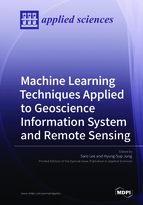Machine Learning Techniques Applied to Geoscience Information System and Remote Sensing
A special issue of Applied Sciences (ISSN 2076-3417). This special issue belongs to the section "Mechanical Engineering".
Deadline for manuscript submissions: closed (28 February 2019) | Viewed by 102096
Special Issue Editors
2. Department of Geophysical Exploration, Korea University of Science and Technology, 217 Gajeong-ro Yuseong-gu, Daejeon 34113, Republic of Korea
Interests: GIS application; geological hazard; geological resources
Special Issues, Collections and Topics in MDPI journals
2. Department of Geoinformatics, University of Seoul, 163 Seoulsiripdae-ro, Dongdaemun-gu, Seoul 02120, Republic of Korea
Interests: SAR; InSAR; GeoAI; sensor modeling; satellite image processing
Special Issues, Collections and Topics in MDPI journals
Special Issue Information
Dear Colleagues,
As computer and space technologies have been developed, geoscience information systems (GIS) and remote sensing (RS), which deal with the spatial information, have been maturing rapidly. In addition, over the last few decades, machine learning techniques have been successfully applied to science and engineering research fields. Machine learning techniques have been widely applied to GIS and RS research fields and have recently produced valuable results in the areas of geoscience, environment, natural hazards and natural resources.
This Special Issue of Applied Sciences, “Machine Learning Techniques Applied to Geoscience Information System and Remote Sensing”, aims to attract novel contributions covering machine learning techniques applied to GIS and RS.
Topics of interest include, but are not limited to:
- Application of machine learning techniques combined with GIS
- Application of machine learning techniques to remote sensing
- Application of machine learning techniques to Global Positioning System (GPS)
- Spatial analysis and geocomputation based on machine learning techniques
- Spatial Prediction using machine learning techniques
- Data processing of geoinformation using machine learning techniques
- Comparison analysis among several machine learning techniques applied to GIS and RS
- Application of machine learning techniques on geosciences, environments, natural hazards and natural resources as case studies
Prof. Dr. Saro Lee
Prof. Dr. Hyung-Sup Jung
Guest Editors
Manuscript Submission Information
Manuscripts should be submitted online at www.mdpi.com by registering and logging in to this website. Once you are registered, click here to go to the submission form. Manuscripts can be submitted until the deadline. All submissions that pass pre-check are peer-reviewed. Accepted papers will be published continuously in the journal (as soon as accepted) and will be listed together on the special issue website. Research articles, review articles as well as short communications are invited. For planned papers, a title and short abstract (about 100 words) can be sent to the Editorial Office for announcement on this website.
Submitted manuscripts should not have been published previously, nor be under consideration for publication elsewhere (except conference proceedings papers). All manuscripts are thoroughly refereed through a single-blind peer-review process. A guide for authors and other relevant information for submission of manuscripts is available on the Instructions for Authors page. Applied Sciences is an international peer-reviewed open access semimonthly journal published by MDPI.
Please visit the Instructions for Authors page before submitting a manuscript. The Article Processing Charge (APC) for publication in this open access journal is 2400 CHF (Swiss Francs). Submitted papers should be well formatted and use good English. Authors may use MDPI's English editing service prior to publication or during author revisions.
Keywords
- Machine learning
- Data mining
- Spatial Database
- Geoinformatics
- Geoscience Information System (GIS)
- Remote Sensing
- Global Positioning System (GPS)
- Spatial Analysis







